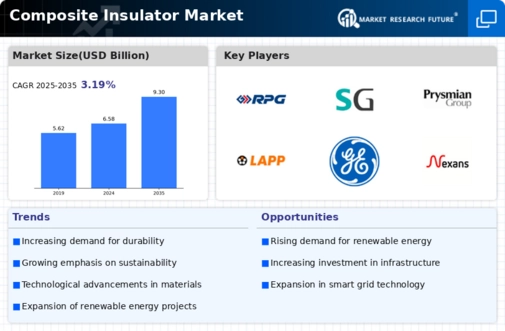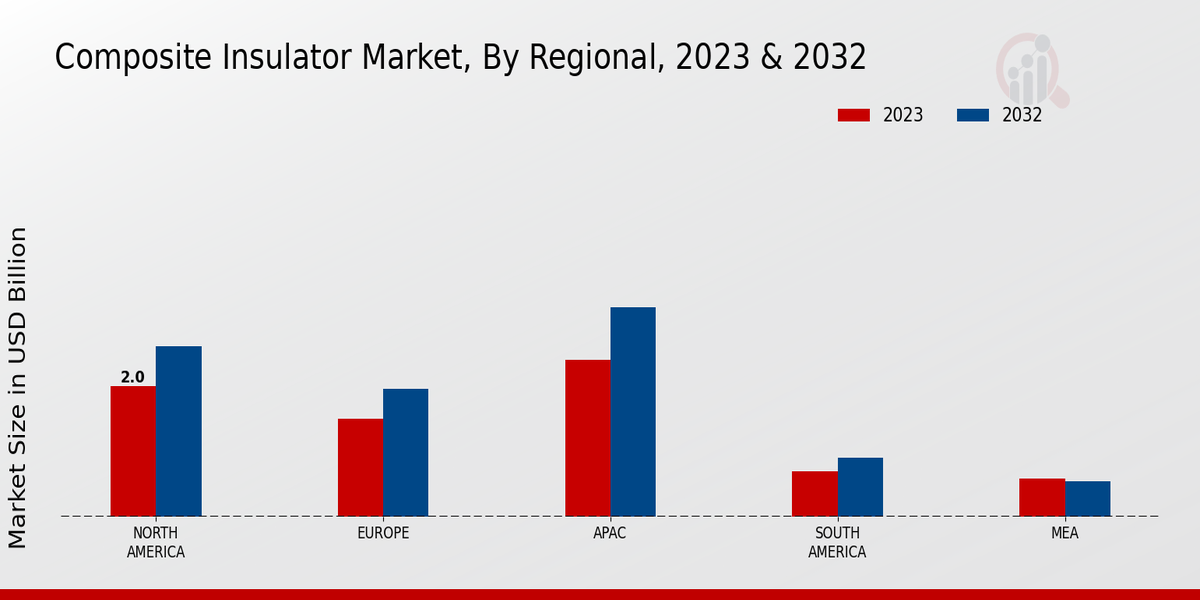Market Growth Projections
The Global Composite Insulator Market Industry is poised for substantial growth, with projections indicating a market value of 6.58 USD Billion in 2024 and an anticipated increase to 9.3 USD Billion by 2035. This growth trajectory reflects a compound annual growth rate (CAGR) of 3.19% from 2025 to 2035, driven by various factors including technological advancements, infrastructure modernization, and increasing demand for renewable energy. The market's expansion is indicative of the critical role composite insulators play in enhancing the reliability and efficiency of electrical systems globally.
Growing Demand for Renewable Energy
The increasing global emphasis on renewable energy sources is a pivotal driver for the Global Composite Insulator Market Industry. As countries strive to meet sustainability goals, the integration of wind and solar power into existing grids necessitates reliable insulation solutions. Composite insulators, known for their superior performance in harsh environments, are becoming essential in these applications. For instance, the global renewable energy capacity is projected to reach 4,000 GW by 2024, further propelling the demand for composite insulators. This trend is expected to contribute significantly to the market's growth, with a projected value of 6.58 USD Billion in 2024.
Environmental Regulations and Standards
The implementation of stringent environmental regulations and standards is shaping the Global Composite Insulator Market Industry. Governments worldwide are mandating the use of materials that minimize environmental impact, leading to a shift towards composite insulators. These insulators not only offer superior performance but also align with sustainability goals. For instance, the European Union's directives on reducing greenhouse gas emissions are prompting utilities to adopt eco-friendly materials in their infrastructure. This regulatory landscape is likely to drive the market's growth as companies seek compliance while enhancing their operational efficiency.
Rising Urbanization and Electrification
The rapid pace of urbanization and the corresponding rise in electrification rates are critical drivers for the Global Composite Insulator Market Industry. As urban populations expand, the demand for reliable electrical infrastructure increases. This trend is particularly evident in developing regions, where governments are prioritizing electrification to support economic growth. For example, in Asia-Pacific, urbanization is projected to reach 66% by 2025, necessitating the installation of robust electrical systems. Consequently, the demand for composite insulators is expected to surge, contributing to the overall market growth and enhancing the reliability of urban electrical networks.
Infrastructure Modernization Initiatives
Many nations are undertaking extensive infrastructure modernization initiatives, which are likely to bolster the Global Composite Insulator Market Industry. Governments are investing in upgrading aging electrical grids to enhance efficiency and reliability. For example, the United States has allocated substantial funding for infrastructure improvements, which includes the replacement of outdated insulators with advanced composite materials. This modernization is anticipated to drive the market's value, potentially reaching 9.3 USD Billion by 2035. The focus on enhancing grid resilience and reducing maintenance costs further underscores the importance of composite insulators in contemporary electrical infrastructure.
Technological Advancements in Insulator Design
Technological advancements in the design and manufacturing of composite insulators are significantly influencing the Global Composite Insulator Market Industry. Innovations such as improved materials and manufacturing techniques enhance the performance and longevity of insulators. For instance, the development of hydrophobic materials has led to better performance in wet conditions, reducing the risk of flashovers. These advancements not only improve safety but also lower maintenance costs for utility companies. As a result, the market is expected to grow at a CAGR of 3.19% from 2025 to 2035, reflecting the increasing adoption of these advanced insulators.






















